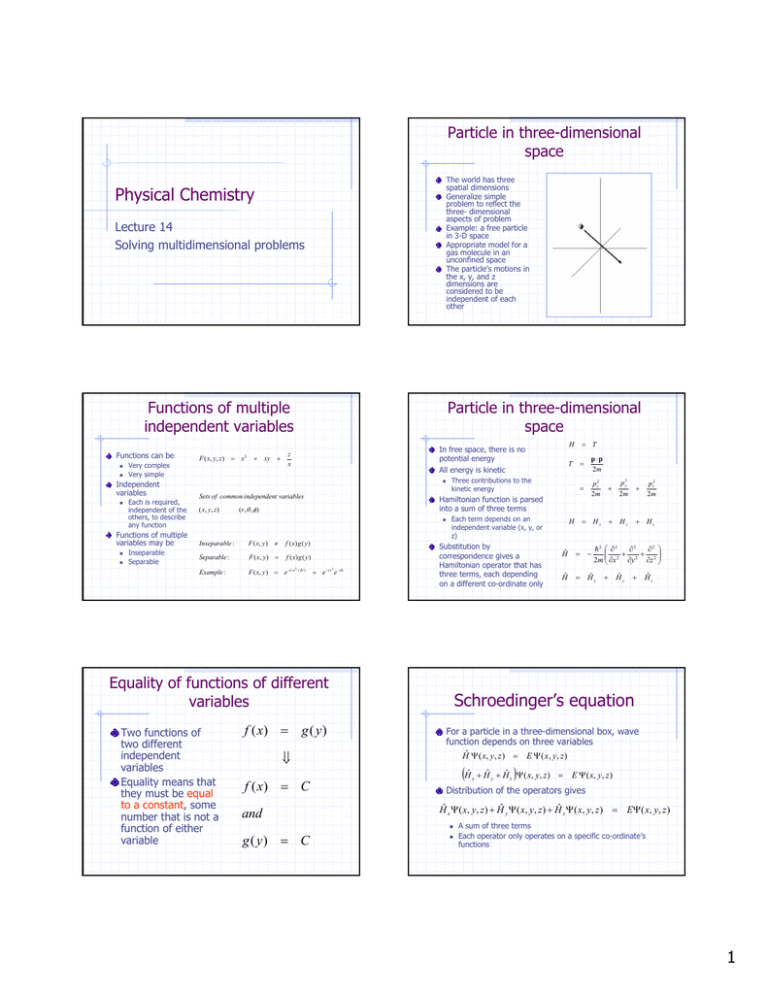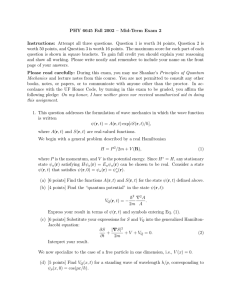Physical Chemistry Functions of multiple independent variables
advertisement

Particle in three-dimensional space The world has three spatial dimensions Generalize simple problem to reflect the three- dimensional aspects of problem Example: a free particle in 3-D space Appropriate model for a gas molecule in an unconfined space The particle’s motions in the x, y, and z dimensions are considered to be independent of each other Physical Chemistry Lecture 14 Solving multidimensional problems Functions of multiple independent variables Functions can be Very complex Very simple Independent variables Each is required, independent of the others, to describe any function Functions of multiple variables may be Inseparable Separable F ( x, y , z ) x2 xy Particle in three-dimensional space In free space, there is no potential energy All energy is kinetic z x Sets of common independent variables ( x, y , z ) Inseparable : F ( x, y ) f ( x) g ( y ) F ( x, y ) f ( x) g ( y ) Example : F ( x, y ) e ( cx 2 dy ) e cx e dy f ( x) g ( y ) 2 Each term depends on an independent variable (x, y, or z) Substitution by correspondence gives a Hamiltonian operator that has three terms, each depending on a different co-ordinate only and p x2 2m H Hx p y2 2m Hy p z2 2m Hz 2 2 2 2 2m x 2 y 2 z 2 Hˆ Hˆ Hˆ x Hˆ y Hˆ z For a particle in a three-dimensional box, wave function depends on three variables Hˆ ( x, y, z ) E ( x, y, z ) Hˆ x Hˆ y Hˆ z ( x, y, z ) E ( x, y, z ) Distribution of the operators gives Hˆ x ( x, y, z ) Hˆ y ( x, y, z ) Hˆ z ( x, y, z ) E ( x, y, z ) g ( y) C Schroedinger’s equation f ( x) C p p 2m Three contributions to the kinetic energy Equality of functions of different variables Two functions of two different independent variables Equality means that they must be equal to a constant, some number that is not a function of either variable T Hamiltonian function is parsed into a sum of three terms (r , , ) Separable : H T A sum of three terms Each operator only operates on a specific co-ordinate’s functions 1 Particle in three-dimensional space (x, y, z) Hˆ Hˆ x Hˆ ( x , y , z ) Hˆ x x x (x) Hˆ y ( y ) z (z) y Hˆ ( x, y, z ) x ( x)y ( y )z ( z ) e ik x x e E z E (x, y, z) ( x ) y ( y ) z ( z ) Hˆ z x ( x ) y Ex E y Ez k y2 2 k x2 2 k 2 2 z 2m 2m 2m Hˆ y x ( x ) y ( y ) z ( z ) ( y ) z (z) E x (x) y ( y ) z (z) Assume the 3D wave function is separable into a product of functions of the independent variables Hamiltonian is sum of Hamiltonians Particle in three-dimensional space Each depends on a single independent variable y ( y )z ( z ) x ( x)y ( y )z ( z ) Hˆ x x ( x) 1 Hˆ x x ( x ) x ( x) x ( x )z ( z ) Hˆ y y ( y ) x ( x)y ( y )z ( z ) 1 Hˆ y y ( y ) y ( y ) 1 Hˆ x x ( x ) E x ( x) x ( x)y ( y ) x ( x )y ( y )z ( z ) Hˆ z z ( z ) E 1 ˆ H z z ( z ) E z ( z ) 1 Hˆ y y ( y ) y ( y ) 1 Hˆ z z ( z ) z ( z ) F ( x ) G ( y, z ) Other separable models Particle in a box of n dimensions Modes of motion of a molecule Translation of center of mass Electronic state Whole-body rotation of the molecule Vibrational modes of the molecule trans elect rot vib E Etrans Eelect Erot Evib Each depends on a single independent variable F ( x) G ( y , z ) 1 Hˆ x x ( x) E x x ( x ) Hˆ x x ( x) E x x ( x ) Hˆ y y ( y )z ( z ) Hˆ z y ( y )z ( z ) Hˆ y y ( y ) E y y ( y ) E Ex y ( y )z ( z ) Hˆ z z ( z ) E z z ( z ) Ex Ey Ez Assumption gives 3 equations for the three parts of the wave function 2 k k 2m Each wave function depends on its own quantum number Particle in three-dimensional space E e ik r Total energy is a sum of the energies of the independent motions Assume the 3D wave function is separable into a product of functions of the independent variables Hamiltonian is sum of Hamiltonians e Assumption gives a wave function that is a product Particle in three-dimensional space y ( y )z ( z ) Hˆ x x ( x) x ( x )z ( z ) Hˆ y y ( y ) x ( x )y ( y ) Hˆ z z ( z ) Ex ( x )y ( y )z ( z ) ik y y ik z z Each equation is like the 1-D equation previously solved Total energy is a sum of the energies of the independent motions Particle in a 3-D box Each mode is exactly like the particle in a 1-D box Solutions and energies of these modes are known Overall solution nx n y nz ( x, y, z ) En x n y n z 23 n x n yy nzz sin sin x sin abc a b c 2 h 2 nx2 n y nz2 2 2 2 8m a b c 2 Probability plots for a particle in a 2-D box Upper graph nx = 1 ny = 1 Lower graph Summary Can sometimes separate wave functions into parts that represent independent energies of the molecule Separation of variables simplifies the complex problem into simpler lower-dimensional problems Have to identify independent variables nx = 1 ny = 2 f Easy for simple problems More complex for real problems Example of a particle in three dimensions Note the symmetry of the graphs and how it changes depending on the relationship of the eigenvalues Translation separable into movement along three orthogonal directions Reduces to three 1-D problems Multiple dimensions introduces the effects of symmetry on the problem High symmetry results in degeneracy of energy levels g Symmetry and degeneracy For the particle in a 2-D box, the energies depend on the size of the box in each direction When a = b, The box is square The states (n,m) and (m,n) have the same energy Symmetry of the potential energy increases the number of states at a particular energy Degeneracy increases because of symmetry Very important relation used to determine symmetry properties of systems Quantum model problems System Model Gas molecule Particle in a Box Bond vibration Harmonic oscillator Potential Energy Differential Equation Solutions Either 0 or Bounded wave equations Sines and cosines (k/2)(r-req)2 Hermite’s equation Hermite polynomials Spherical harmonic (angular momentum) Spherical harmonic functions Either 0 or Molecular rotation Rigid rotor Hydrogen atom Central-force problem -Ze2/r Legendre’s and Laguerre’s equations Legendre polynomials, Laguerre polynomials, spherical harmonic functions Complex systems Multi-mode systems Complex Complicated equations Complex products of functions 3








